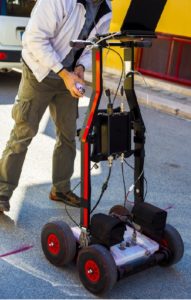
Find out about the most common utility locating methods.
Having your utilities located before digging is a crucial first step to preserving the safety of workers and for being more efficient on any project on which you might be working. There are a couple of ways you can go about finding underground obstructions. Find out about the most common utility locating methods.
Electromagnetic Utility Locating
Electromagnetic utility locating is the most common method for detecting items below the surface. Using this method, you use tools that emit electromagnetic radio frequencies when they come into contact with the ground. A receiver can locate any subsurface utilities that have conductive material while scanning.
This form of utility locating is usually used to find gas, cable, water, irrigation lines, and propane, among other things. It has a shortcoming, though, because it cannot detect asbestos, concrete, and unmarked plastic. It also doesn’t do well if it has to go too far below the surface. Electromagnetic utility locating will only work well until it gets 10-15 feet underground.
Ground-Penetrating Radar
Ground-penetrating radar (GPR) is used for subsurface utility locating that has high-frequency pulses. Radio waves get sent into the ground, and any utilities found underground will reflect the radio waves up to the surface. Once the radio waves are sent back, the operator can see what was obstructing the path. GPR is usually used for tanks, manholes, and buried pipes, among other buried things.
GPR has its shortcomings, as well. It struggles with high-conductivity soils because they make it hard for GPR to get through the soil. Also, high-frequency GPR antennas will only work a small distance below the surface. GPR also has a harder time finding objects as they get deeper into the ground. As a general rule of thumb, an object has to be an extra inch in diameter for every foot beneath the surface GPR has to travel. As an example, if there is an underground pipe and it’s 4 feet below the surface, it has to be at least 4 inches in diameter to be detected.
Hydro or Vacuum Excavation (potholing)
Vacuum excavation is a quick and non-destructive utility locating method. Using this method, high-pressure air breaks down the soil. Then the soil gets sucked into a tank. Hydro excavation is a little different because it uses pressurized water to break down the soil instead before it gets sucked into a tank.
Concrete Visions Will Get The Job Done Right
Concrete Visions has been working with clients for over 25 years. Our G&M Services installers are certified with the industry’s major firestop product manufacturers. As part of our firestop service, we can assess abnormal field conditions and, with the manufacturer’s technical support assistance, provide engineering judgments in a timely fashion to comply with contract specifications. Our Field Mechanics undergo ongoing training, including mandatory monthly safety meetings, weekly Toolbox Talks where safety and equipment information is shred, and trainings on safe work standards and safety best practices.
